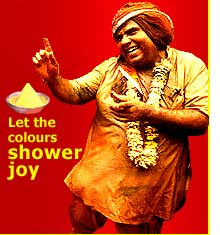
India is a land of great diversity. It described as a land of many religions and innumerable languages, it might well be described as a land of festivals as well. Indians love celebrating. Every little occasion from the harvesting of crops, welcoming the spring or rain, to seeing the full moon lends itself to joyous celebrations splashed with colors, music, folk dances and songs. Even the birthdays of divine beings are celebrated by connecting them with particular festivals.
The Indian calendar is one long procession of festivals. These are as varied in origin as they are large in number. India is a multilingual, multi-religious, multi-cultural nation.
The homes are neatly decorated, new dresses are worn for every occasion, prayers offered to Gods, and lot of sweets and goodies are cooked. Most of these festivals are common to most part of India however they may be known by different names in different parts of the country. Different cultures also mean that different rituals are followed.
Indian festivals are celebrated according to the solar and lunar calendars. Consequently, dates & months may vary accordingly.
Here's a list of common festivals celebrated all over India.
January:
Lohri : Lohri marks the culmination of winter, and is celebrated on the 13th day of January in the month of Paush or Magh, a day before Makar Sankranti. For Punjabis, this is more than just a festival, it is also an example of a way of life. Lohri celebrates fertility and the spark of life. People gather round the bonfires, throw sweets, puffed rice and popcorn into the flames, sing popular songs and exchange greetings.
Makar Sankranti / Pongal : These are celebrated predominantly in the southern part of India. This harvest festival marks the commencement of the sun's journey to the Northern Hemisphere. People take dips in rivers and worship the sun In Gujarat, Makar Sankranti is celebrated by the flying of kites.
Republic Day: Celebrating the anniversary of India's establishment as a Republic 26th January 1950, all the state capitals resound with the beating of drums and parading of the army. Delhi, the national capital of India has the grandest parades, displaying India's strength in terms of the armed forces and weapons. These are followed by floats and dancers from all parts of the country.
February :
Maha Shivratri :Maha Shivaratri This is a day of fasting dedicated to Lord Shiva, the third deity of the Hindu trinity. Religious people stay awake and chant prayers the whole night. Processions to the festivals are followed by chanting of mantras and anointing of lingams.
Vasant Panchami is a festival in honor of Saraswati, the goddess of wisdom and learning.
March :

Holi : This is one of the most exuberant festivals and also the most colorful. It heralds the advent of spring and the end of winters. It is celebrated by throwing colored water and powder at each other. On the eve of Holi, bonfires are built to symbolize the destruction of the evil demon Holika.
Mahavir Jayanti : is a major Jain festival and commemorates the birth anniversary of Mahavira, the 24th and last Jain Tirthankar. It is a day of prayer. There are celebrations in all Jain temples and pilgrimages to Jain shrines.
Ram Navami : is the day of Rama's birth and is celebrated as a day of great piety, with the chanting of prayers and the singing of ballads.
April :
Easter and Good Friday : Good Friday is observed in India in April every year, broadly on the pattern adopted worldwide. Christians from all stratas of society visit the Church to attend the Mass held on this occasion. Easter Sunday, which follows Good Friday is celebrated with much joy and gaiety. Processions are taken out in some parts of the country.
Baisakhi : Baisakhi, celebrated with joyous music and dancing, is New Year's Day in Punjab. It falls on April 13, though once in 36 years it occurs on 14th April. It was on this day that the tenth Sikh Guru, Guru Gobind Singh, founded the Khalsa (the Sikh brotherhood) in 1699. The Sikhs, therefore, celebrate this festival as a collective birthday.
Id-ul-Fitr or Ramazan Id : is a day of feasting and rejoicing as it marks the end of the end of Ramazan (Ramadan), the Muslim time of fasting.
May - June :
Buddha Purnima : The Buddha's birth, enlightenment and his reaching nirvana are all celebrated on this day. The Buddha is supposed to have gone through each of these experiences on the same day, but of different years.
July :
Naga Panchami :This festival is dedicated to Ananata, the serpent whose coils Lord Vishnu rests between universes. Offerings are made to snake images. Snakes are supposed to have the power over the monsoon rainfall and keep evil from homes.
August :
Raksha Bandhan : is an integral part of the Hindu family structure whereby a woman ties a rakhi or decorative thread on the wrist of her brother to remind him to protect her if the need arises.
Independence Day : The anniversary of India's independence commemorates the day on August 15th. The prime Minister delivers an address from the ramparts of Delhi's Red Fort. It is celebrated all over the country with meetings and flag-hosting ceremonies.
September - October - November :
Janamashtami : The birth of lord Krishna, the eighth incarnation on earth of Lord Vishnu, is celebrated throughout India. Devotees celebrate it by fasting and prayers, which is followed by feasting and merriment.
Id-ul-Zuha or Bakrid : celebrates the sacrifice of Hazrat Ibrahim, who willingly agreed to kill his son at the behest of God. To celebrate the event Muslims sacrifice one animal per family or group of families. There are prayers in mosques, feasting, and rejoicing. New cloches are worn and visits and greetings are exchanged.
Onam : is celebrated Kerala, Andhra Pradesh and Tamil Nadu. It is celebrated against a setting of lush green vegetation. This picturesque harvest festival brings ten days of colour, feasting, boat races, song and dance to the state.
Ganesh Chaturthi : This festival is dedicated to the popular elephant headed God, Ganesha. Pune, madras, and Bombay are the important centers of celebration. In Maharashtra, huge images of Ganesha are carried in procession. On specific dates in the following ten days, these images are immersed in the sea or rivers with thousands of worshippers dancing and singing after them.
Navaratri/Dussehra/Durga Pooja. : Navaratri, the Festival of Nine Nights, is celebrated in honor of goddesses Durga, Lakshmi, and Saraswati. The tenth day, Dussehra, commemorates the victory of Rama, of the epic Ramayana, over Ravana. In many places it culminates with the burning of huge images of Ravana and his accomplices, celebrating the victory of the good over evil. Re-enactments of the epic Ramayana takes place in various places.
 Gandhi Jayanthi : A solemn celebration marking the birth date of Gandhiji, the father of the nation, includes prayer meetings at the Raj Ghat where he was cremated. Gandhi Jayanthi : A solemn celebration marking the birth date of Gandhiji, the father of the nation, includes prayer meetings at the Raj Ghat where he was cremated.
Diwali or Deepawali : This is perhaps the happiest of Hindu festivals.Of all the festivals celebrated in India, Diwali is by far the most glamorous and important. is a festival of lights symbolizing the victory of righteousness and the lifting of spiritual darkness. Countless number of lamps are lighted at night, giving the impression that the stars have descended on earth.
Gurpurab: The birth anniversaries of Guru Nanak, the founder of Sikhism (October-November), and of Guru Gobind Singh, the last Guru (December-January), are important festivals of the Sikhs. In addition to the reading of the holy verses, the Guru Granth Sahib, the Sikh holy book, is carried in procession.
Govardhan Pooja : A Hindu festival dedicated to the holiest of animals for the Hindus, the cow.
Bhai Dhuj
Guru Nanak Jayanthi is celebrated as the birth anniversary of Guru Nanak, the founder of Sikh religion.
December :
 Chrismas : Christians in India celebrate their festivals broadly on the pattern adopted worldwide. However some influence of local Indian tradition has been absorbed into the festivities. . Christmas is a major event in all Indian Christian households and one can see Goa come to life at this time of the year. Chrismas : Christians in India celebrate their festivals broadly on the pattern adopted worldwide. However some influence of local Indian tradition has been absorbed into the festivities. . Christmas is a major event in all Indian Christian households and one can see Goa come to life at this time of the year. |
No comments:
Post a Comment